The Health Benefits of Chocolate Made From Plants
By: Jess Guht, B.S., M.Eng Biomedical Engineering
Everyone gets a craving for chocolate from time to time, but many people who are vegan may wonder which type of chocolate matches their dietary preferences (while still tasting delicious!). You may also wonder if there are health benefits of vegan chocolate. Whatever your reason for going vegan or looking for a dairy-free chocolate formula, ALOHA offers products with vegan chocolate that can satisfy your chocolate craving, without the dairy.

The Origins of Vegan Chocolate
The chocolate bars we think of today are very different from their original forms.
Chocolate has a rich history, dating back almost 4,000 years when the cacao bean was first crushed up and mixed with water and added spices, making the drink ‘xocoatl.’
Chocolate is also well-documented in its use by the Mayans, who not only consumed chocolate but revered it. Chocolate drinks were used in their civilization during celebrations and to finalize important transactions. However, chocolate was not hoarded in Mayan culture and was enjoyed by everyone at every meal, no matter their wealth. Mayan chocolate was thick and frothy, and they often combined it with honey, chili peppers, or water.
With the Aztecs, the fascination with chocolate took another step and became a type of currency used to buy food and other goods. For the Aztecs, chocolate cacao beans were considered to be more valuable than gold.
It wasn’t long before chocolate made its way to Europe, where chocolate mania soon spread.
In 1847, the first chocolate bar was made from a paste of chocolate liquor, sugar, and cocoa butter, showing that the first ever chocolate bar was vegan! In fact, milk wasn’t added to chocolate (making milk chocolate) until 1876.

Is All Chocolate Vegan?
There is no definitive answer to if chocolate is vegan because it can depend on the type of chocolate you use.
The essence of chocolate is the beans of the cacao tree, but other ingredients are added, such as sugar, flavorings, or milk. However, not all chocolate contains milk, so some types of chocolate are vegan.
Making Chocolate
To make chocolate, the seeds of the cacao tree must first be fermented, which helps to develop flavor and remove the bitter taste. After fermentation, the cacao beans are cleaned, dried, and roasted, and then the shell is removed, revealing the cacao nibs.
The cacao nibs are then ground, forming chocolate liquor, which is a deep, dark brown color and has a rich, bitter taste. Chocolate liquor is then blended with cocoa butter and different additives to make the different types of chocolate.
Milk chocolate is made by blending chocolate liquor, cocoa butter, milk or milk powder, sugar, and vanilla, making it more processed than vegan chocolate.
In comparison, most types of dark chocolate follow the same formula as milk chocolate. However, they do not contain milk or milk powder, which is why they are a vegan alternative. Some types of vegan chocolate may also use soy lecithin, which acts as a binder, similar to milk.
It’s always important to check the ingredients of your dark chocolate, though, because some companies may still sneak in dairy products, making the chocolate non-vegan. To be safe, look for ingredients derived from milk, such as casein, whey, milk fat, and milk solids.

Vegan Chocolate: A More Environmentally Friendly Option
As with all industries, there is a certain level of environmental impact associated with chocolate production. However, vegan chocolate is better for the environment than milk chocolate.
Since vegan chocolate does not use milk, there is less of a need for cows. While cows may be cute, they produce methane gas which contributes to ground-level ozone. Additionally, more farmlands are needed to grow food for the cows, furthering the environmental impact of milk chocolate. By eating dark chocolate, you are choosing a more climate-conscious choice.
The Many Forms of Chocolate
While we typically think of chocolate in one form (chocolate bars), it actually has many components, each with its own benefits.
Dark Chocolate
You may be wondering, what is in dark chocolate? Dark chocolate typically has a 50-90% cocoa percentage, meaning that percentage of the chocolate is made from cocoa beans. The remaining percentage consists of additional ingredients. The higher the percentage, the more bitter the chocolate can taste. Compared to milk chocolate, dark chocolate is not made with milk and may use soy lecithin as a binder.
Dark Chocolate Benefits
It is not a myth that there are health benefits of chocolate. The dark chocolate benefits include that it is one of the best sources of antioxidants which may help reduce oxidative stress in the body. Dark chocolate also possesses nutrients that may help lower blood pressure, protect against high cholesterol, reduce heart disease risk, and improve brain function.
Dark chocolate is a common component of desserts because it is not too sweet to detract from the overall flavor. Additionally, it can be enjoyed melted on fruit or sprinkled on top of a smoothie bowl. Many people also enjoy eating dark chocolate plain, although the higher its percentage, the less palatable it may be on its own.
Dark chocolate is an ingredient in our Chocolate Mint, Peanut Butter Cup, and Chocolate Fudge Brownie Protein Bars.

Chocolate Liquor
While the name suggests otherwise, chocolate liquor is a nonalcoholic liquid. Chocolate liquor is composed of two parts, cocoa butter and cocoa solids (cocoa powder). The chocolate liquor then goes through a process called conching, where additional flavoring and ingredients such as sugar, more cocoa butter, or vanilla are added.
.
.
.
Cocoa Butter
Cocoa butter is produced when the chocolate liquor, also known as the cocoa mass, is heavily pressed until the cocoa butter is squeezed out. Cocoa butter has no flavor or aroma of chocolate, but it provides the smoothness that is associated with chocolate. This is because it has a very low melting point, which is why chocolate will melt in someone’s mouth.
Cocoa butter is a staple in desserts such as chocolate bars and fudge layer cakes. If the mention of cake made your mouth water and stomach growl, here’s a recipe for vegan chocolate cake.
It is also a common ingredient in many skin care products. The high fatty acid content in cocoa butter may help hydrate the skin and improve elasticity. Additionally, the fat in cocoa butter forms a protective layer on the skin, which may help lock in moisture. Because of these qualities, cocoa butter is very common in creams and lotions. It is also frequently used in lip balms because it is edible.
Cocoa butter is a common ingredient in our protein bars. It can be found in the Peanut Butter Chocolate Chip, Chocolate Chip Cookie Dough, Chocolate Espresso, Peanut Butter Cup, Chocolate Fudge Brownie, Coconut Chocolate Almond, and Chocolate Mint Protein Bar.

Cocoa Powder
Once the cacao fat has been removed from ground cacao nibs, it is pressed into a cake and then pulverized, creating cocoa powder.
Cocoa powder is an extremely popular ingredient in most chocolate-based recipes, from cookies to cakes to brownies. ALOHA even has the perfect recipe for vegan brownies with a healthy twist with the use of our chocolate protein powder! However, its uses are not only applicable to dessert, and cocoa powder can also be used as a rub for red meats.
Some of our protein bars featuring cocoa powder include Chocolate Mint, Chocolate Espresso, Chocolate Fudge Brownie, and Coconut Chocolate Almond. Cocoa powder is also found in our Vegan Chocolate Protein Powder.
Cocoa Nibs
The cocoa nibs are found inside the cacao beans when they are cracked open. This is the raw form of cacao before it is made into chocolate liquor, and because they are a raw form of cacao, they are pretty bitter. However, since they are a pure form of cacao, they are naturally low in sugar while also being rich in nutrients such as magnesium, which is used by the body for certain enzyme reactions and may help maintain healthy bones.
Cocoa nibs are a common addition to smoothies or can be used as yogurt topping to add a chocolate twist.
We have also added cocoa nibs to some of our protein bars to add an extra chocolate crunch. Try the Chocolate Chip Cookie Dough or Chocolate Espresso Protein Bars to see cocoa nibs in action.

Cocoa Extract
It’s said that cacao beans lose their “top notes” of flavor when processed into chocolate, but cocoa extract can help to return these top notes. It is used in baking to add layers of flavor to the dessert, intensifying the cocoa taste.
To create cocoa extract, alcohol is used to extract and conserve cocoa’s concentrated taste. Starting with cacao nibs, they are gently crushed to help release their flavor and speed up the ripening process. Vodka, bourbon, or rum is then poured over the cocoa nibs, and the jar is sealed tightly before given a good shake.
The jar with alcohol and cocoa nibs is then stored in a dark place anywhere from three to six months; the longer it is stored, the more depth the flavor of the cocoa extract will have.
Our Chocolate Fudge Brownie Protein Bar contains cocoa extract, giving it that extra dimension of chocolatey goodness.

Semisweet Chocolate Chips
Semisweet chocolate typically contains around 60% chocolate liquor, and when in chocolate chip form, it is a perfect bite-sized addition to whatever snack you are making.
Semisweet is an appealing option for those with a sweeter tooth who do not like the flavor of bittersweet chocolate. It is also a good addition for recipes that are not very sweet, as it adds chocolate flavor without too much sweetness.
We use semisweet chocolate chips in our Peanut Butter Chocolate Chip, Chocolate Chip Cookie Dough, Chocolate Espresso, and Coconut Chocolate Almond Protein Bars.
Enjoying Vegan Chocolate
Chocolate has come a long way since its beginnings, but it remains a treat that most everyone enjoys indulging in. For those looking for vegan chocolate, ALOHA utilizes vegan dark chocolate in many of our protein bars and protein powders, providing a sweet, delicious, and dairy-free treat.
Author Biography:

Jess Guht is a medical content writer who graduated from Rutgers University with both a B.S. and M.Eng. in Biomedical Engineering. She currently writes medical content pieces for any brand that she can share a passion with. In her own words, "With every single article or scientific article I summarize, I get to immerse myself in the field I love and create something that everyone can understand."











